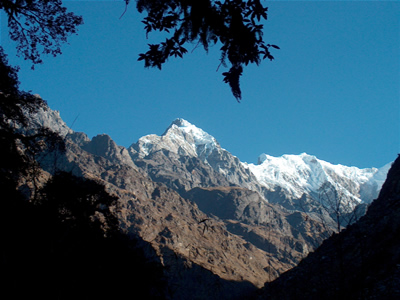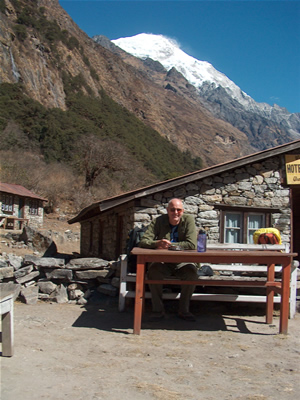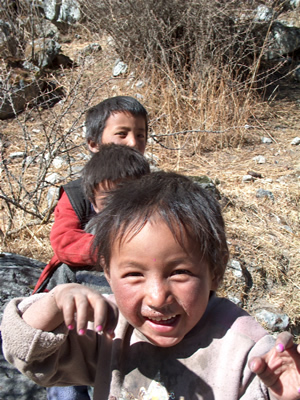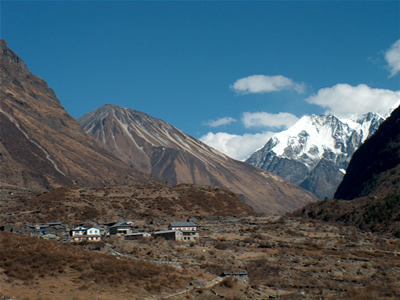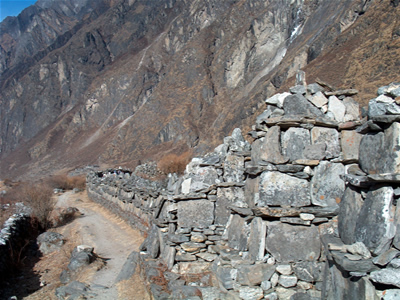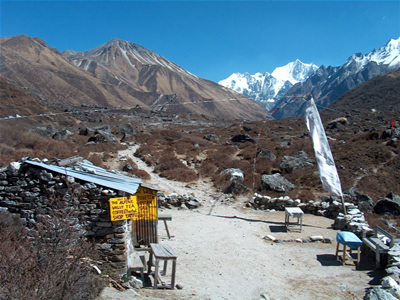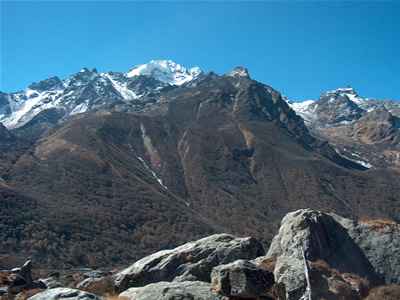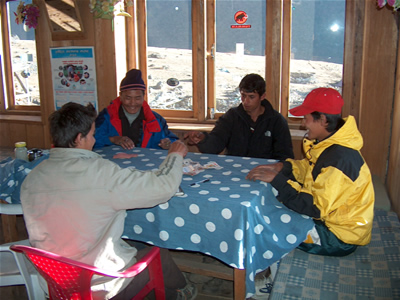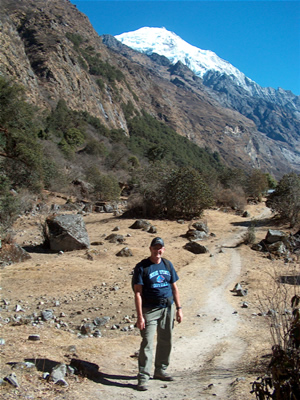Langtang Valley
At Lama Hotel the valley of the Langtang Khola makes a ninety degree turn to the left. Although the canyon had been very scenic the day before, the sharp bend in it prevented us from seeing the upper valley or any of the peaks around it. Starting out in the morning we entered a forest and hiked up a gradual slope. The forest was cool and shaded, especially early in the morning, but the exercise kept me plenty warm. The trail followed the river which was always scenic. Finally we came to some gaps in the trees where we could see the peaks of the Langtang massif up ahead shining in the sun. This is why I had come to Nepal again.
We eventually climbed out of the forest and entered the upper valley where we were above tree line. The sun was warm but not hot. All around were beautiful peaks. We stopped for our midmorning break and I enjoyed a Coke while sitting in the sun taking in the view. This was one of the busiest stops of the whole trek. There was an older British couple taking a break. They said that they traveled to Nepal every year and had done the Langtang trek several times. But they were back again because it was one of their favorites.
There were also two young Canadians who told me that they had taken the public bus to the trailhead the day after I rode up in a jeep. Because the inside of the bus was full of luggage they had to ride with lots of people on top of the bus holding on to the luggage racks. If I thought the ride up was scary on that road, they said it was absolutely terrifying. But they also said that some of the time the dust was so bad that you couldn't see how scary the drop off was and they were more worried about breathing than falling. Normally the bus takes ten hours but they were stopped by a group of people holding a strike on the road and that delayed them a long time. The trip from Kathmandu ended up taking them fourteen hours but they said that they felt lucky that they had made it through at all. This was only one day after I had driven to the trail head with no problems. Nope. I was glad that I had paid the extra $100USD to get a private jeep for transportation to and from the ends of the trek. And I was lucky to just miss the demonstrations. They are not that unusual in the third world.
Suddenly there was some excitement. We heard a commotion nearby and looked to see a potential tragedy. A small Nepali child about three years old had swallowed something and was choking. It must have been bad because the woman next to the child, probably the mother, threw herself on the ground and was screaming and kicking. For just a brief second no one knew what to do. Then a Nepali man grabbed the child and turned it upside down and started to shake it. It wasn't exactly the Heimlich maneuver but it worked and the child could breathe. Mom grabbed the kid and was hugging and kissing it and everyone took a deep breath. It could have been bad though.
The rest of the day was wonderful hiking. The weather was perfect - clear blue sky and cool enough to be comfortable hiking but not cold at all. In the afternoon I stopped to talk to a group of young Nepali children in a small village. I showed them my camera and motioned that I would take their picture. This was a mistake as they swarmed all over me. But I did get a few pictures and they giggled and laughed when I showed them their pictures on the cameras display. It was fun.
We stopped for the night in the village of Langtang. This is a sizeable village with a hundred or more families. The lodge we stayed at had one building with individual rooms for guests. Then there was another building where the Nepalis stayed which I think had more of a communal bunk room. Although I never went inside, I could hear lively conversations going on well into the night. Then there was another building with the kitchen and the dining room. The dining room had the usual big pot bellied stove with a fire in it that was very welcome when the sun went down and it turned cold.
There was another guest at the lodge, a young Norwegian woman, who was really sick. This is a constant worry in Nepal where it is very common to get dysentery from contaminated food or water. Whenever I travel in a third world country I always carry Cipro, a potent antibiotic for gastrointestinal problems. I gave her some from my stash. At that point her guide went into a long discussion about maybe she shouldn't take any medicine because it was too strong, that it might do more harm than good, that she shouldn't mix it with what she had already taken (just some bismuth subsalicylate - which is sold in the US under the name Pepto Bismol) and who knows what else. I got mad as what she needed to do was take the antibiotic and take it as soon as possible. Her guide didn't know what he was talking about. And if he knew his business he wouldn't have taken her to any lodge or tea house where they didn't have good health practices preparing the food. After some (heated) argument, she finally took the antibiotics and sure enough, next morning she was fine. I hate being corrected by people who don't know what they are talking about.
This lodge had a shower as most of the lodges in Langtang did. But this one was unusual. The shower was in the bathroom on the second floor (where my room was) but as far as I could see there was no drain. So when you took a shower the water just got higher and higher. At this altitude it was cool enough that the water wasn't really hot so I didn't take a long shower. There was a step down from the hallway into the bathroom so the room didn't overflow. Somehow the water drained or leaked out somewhere but there was about half an inch of water in the bathroom that was there for most of the night. At least I was the only guest except for the sick lady. It would not have been very hygenic if the hotel was crowded.
Sunset was beautiful. The village was in shadow but the big snow peaks up the valley were still shining in the sunlight. Then they turned pink, then red, and then it got dark. It was quite a show. A good thing about this hotel was that every room had its own electric lights. So after sunset I could read as late as I wanted before going to bed. In other lodges I often had to read by using my headlamp after dark.
The next morning brought another fantastic day. Bright blue sky and beautiful mountains. As we hiked out of the village we passed a shop. One problem I had been having was that I was sneezing and sniffling a lot. I was going though the meager supply of tissues that I had brought along rather quickly. Most of the Nepalis I asked about Kleenex-type tissues didn't know what I was talking about. Remember that this is a country where toilet paper is still a novelty. But this shop we found had a supply of packets of good quality tissues. I bought their entire stock. Now I was set for a long trek.
As we left the village we hiked along long walls made of mani stones. These stones are made by Buddhists as a form of prayer. They are usually inscribed with a holy mantra, Om Mani Padme Hum being the most common. Sometimes they have illustrations of Buddhist sacred figures. They are placed along a path and as travelers pass them it is the same effect as saying the prayer. It is important to always pass with them on your right though! Passing on the wrong side is bad karma, and instead of a prayer walking past the mani stone acts as curse. So there were always two trails, one on each side of the wall. I always tried to respect the local tradition and walk past with the stones on the right side. But if I ever missed seeing one and was about to walk with them on the left Tasi would be very quick to point it out to me. He was a very devout Buddhist and felt that it was very important.
At our midmorning break we stopped at a small tea house. There was just a tiny house with a few tables outside. I had my usual Coke break. There were the usual handicrafts from the region for sale there. I bought some interesting necklaces made from yak bone. The lady who lived in the house was kind enough to pose for a picture with me and then invite all of us into her house for a cup of tea. Her house was a single room, about 12 ft by 20 ft. There was a fireplace for cooking (and heating), a single bed along one wall and a few chairs. There were some shelves along one wall and about two thirds of the floor was wood, the rest was dirt. Her home was very simple but she had a few decorations scattered around. And she was gracious to have us inside and serve us tea. In the high mountains where the weather can be harsh it looked like a tough life.
At our lunch stop I spent some time talking to two guys from Britain. They had been traveling in India and Nepal for several months on the super cheap. You have to be brave to go really cheaply in those countries. They both were from London and worked in digital media. They said that with the economic crisis, they had no idea whether they would even have jobs when they went back. But they were continuing their trip until they ran out of money. They had a lot of places that they still wanted to see in Asia. Not that I cared, but these guys both squeaked when they walked. Artsy types. Made for good hiking partners though, I guess.
While we were talking about the economic crisis one of them made a comment about it being the fault of the "Chicago Boys". I mentioned that the book I was reading on the trek was The Shock Doctrine by Naomi Kline. She used that term for an influential group of economists from the University of Chicago and she definitely blamed them for a lot of the economic problems in the world. Sure enough, these guys were both big fans of the book and we spent a while talking about it. BTW, I would highly recommend the book. It was interesting that they had brought up the very book that I was reading.
That afternoon we reached the village of Kyangjin Gompa at 12.800 ft. What a wonderful spot. We were at the upper end of the Langtang valley surrounded by fantastic peaks. We stayed at the Hotel View Point, an appropriate name. Here there was no shower available as it was still too cold at night. It would freeze and burst the pipes, so no shower. I figured that wasn't a problem for a day or so.
It definitely felt like we were much higher. Even during the afternoon it was colder and windier here. I put on some warmer clothes and read in the dining room rather than outside even though it was still sunny out. There was only one other guest in the hotel, a French Canadian traveling by himself. He noticed my book and asked me about it. He said he had heard a lot about it and was going to read it as soon as he could find it. I told him he could have mine when I finished - unfortunately it took me till the following night to get done. He had also been traveling for many weeks in India and was planning to go to China to stay with friends when he finished his time in Nepal. We talked for a long time that evening and he told me a lot of interesting stories about his travels.
Meanwhile the Nepalis were keeping warm in the dining room as well. Tasi and Khim were playing cards with some Nepalis who were working for some Westerners who were staying at another lodge nearby. They were playing a local game that I did not recognize but the play was very animated. No one just placed a card on the table when it was their turn. Everyone made exaggerated motions where they raised the card high in the air and then smacked it down on the table with a flourish. Every play was accompanied by lots of hoots and hollers and laughter depending on who was winning and losing with each card. The game stopped when dinner was served but then resumed afterwards. It was still going strong when I went up to my room for the night.
